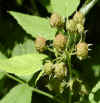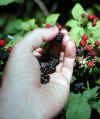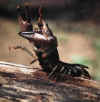| June (written
June 2004)
Aside from the fact that June usually is the mildest and most peaceful
month of the year in terms of weather, there is much to be said and done
about/during the month.
First, I see June as be best fishing month of the year on small and
mid-sized streams. Secondly, June turns green black raspberries red, then
black, to the delight of little ol' wine, jelly, jam and pie/cobbler
makers. And, there is much, much more.
Taking first things first, I like the June fishing on small and mid-sized
streams because they have been "restocked" by high waters during March,
April and May.
Fish are not reputed to have nomadic tendencies, but most species turn
their noses upstream with the spring equinox. When spring rains bring high,
muddy water, they follow their noses, en masse. I saw my first case of
this natural phenomenon in my early teens at good ol' Crothersville in
Southern Indiana.
My dad, the late Jacob W. Scifres, and I were well into bass fishing
(mostly largemouth) with artificial lures, and the two forks (East and
Vernon, a k a West Fork) were our stomping grounds. Having no boat, we
were bank walkers and waders, actually the best way to fish a river or
stream.
Bass were seldom congregated along the two forks of the river, although
deep holes below riffles always held good numbers of fish. But generally,
we caught a few bass here, a few bass there. Still, the fishing was good
because in an afternoon we could cover several miles of stream while leapfrogging
unproductive spots.
But late one summer, when the East Fork (Graham's Creek) was low, a
vegetable-canning company took it upon itself to put a rock dam in the
river (apparently without any right to do so, other than the fact that
the owner was a good political contributor). The dam was designed to hold
more water in the riverbed to provide water for the company's canning operation.
My dad, and other members of our little group of bassers figured the
dam--completed in late summer--would be a collection point for bass. But
it didn't happen late in the summer, or in the fall.
However, on the following Easter Sunday, a beautiful day of sunshine
and mild temperature, Dick Cartwright, Alton Cain, my dad and I (I am the
only survivor now), had to try our luck. We didn't expect to catch a lot
of fish and our expectations were becoming reality. So--since we were in
the area--we decided to go take a close look at the dam.
It was a wild sight, a little scary for me--a deep hole above the dam
and the clear water of the Ol' Muscatatuck (Peaceful Water to the Indians
in the 1800s) cascading over the boulders to form a raceway of white, frothy
water below.
As we stood in awe of this totally unnatural thing, I got the urge to
flip an artificial lure into the swift water below the damn.
"Probably no fish there," the older anglers told me, but being a kid
I had to act like one. I picked my way gingerly over the boulders until
I was standing on a big flat rock with white water gushing past a few inches
from my feet.
At this point I know you must be speculating that I will flip my old
favorite No. 3 Hawaiian Wiggler into the frothy water and run smack into
a mother lode of frisky, flouncing Muscatatuck bass. You speculate well.
As I wound the peppermint-striped lure to the tip of my old tubular-steel
bait-casting rod, I thought a small bass had followed it but had shied
away at the last moment. I didn't mention it, but the next cast found me
fast to a 12-incher, and the cast after that put another bass on the rocks.
By then I was joined by the three older anglers and before we left my
dad's homemade fish bag (he knitted them from a strong twine he called
stagen) held a double limit of bass. The other two anglers kept no fish.
We kept the place secret. But as spring turned to summer, then fall,
I would ride my old fenderless bike to the dam often and would catch bass
until it turned to boredom. The fast water below the dam was a bass convention.
But in the long hole of deep water above the dam the fishing remained spotty.
I may have been the originator of catch-and-release thinking. If I didn't
catch my limit of six bass, or if my mother was tiring of fixing fish dinners,
I put them back.
As a bass fishing hole, in a lifetime of bass fishing the dam rates
second only to Monroe Reservoir in the first year or so after it was opened
to fishing on January 1, 1967.
But a stream or river doesn't need a dam to offer good fishing in June.
Streams may be a bit high this year as June rolls in because of a round
of heavy rains in the waning days of May. But small streams are forgiving
elements of the water drainage system. High waters soon recede and clear
up to return such streams to languid pools separated by riffles and their
complement of game fish will hit high points for the year.
As the dog days of summer arrive, water levels of small streams will
be lower and some of the fish probably will return to the larger waters
from which they came. Others will be caught by anglers or eliminated by
natural enemies. But there is plenty of water--and plenty of fish--in small
streams in June.
My favorite method of fishing small streams in June--or as long as water
levels remain at normal levels--is wading.
Old clothing is the uniform of the day and valuables are locked in the
trunk of my car or hidden somewhere nearby. Chest-high waders or hip boots
are fine, but they tire the angler and generally make wading cumbersome.
Many years ago I developed special equipment for fishing small streams.
I like a very light five-foot rod, a small open-face spinning reel loaded
with four or six-pound-test monofilament line, and small lures (mostly
spinner-bucktail combinations, and terminal tackle for fishing live/natural
baits).
This gear includes a small fly reel with a light, level line in addition
to leader material and a few flies. With this gear I can convert the spinning
outfit to a fly rod of sorts. Fishing small streams does not require long
casts.
Dan Gapen's Hairy Worm-plus (with "L" shaped spinner rig) and its stablemate,
the Ugly Bug (also with spinner rig), are my favorites, but I carry many
other miniature lures, including assortments of Mepps and other small spinner-bucktail
combos. The Colorado spinner of Hildebrandt Corporation (Logansport) also
is a good bet for the clear, deep pools of small streams, especially for
smallmouth and rock bass.
Invaluable in my tackle kit are assortments of light wire hooks, split-shot
sinkers, and small bottle stopper corks (split halfway so they can be slipped
onto the line when wanted). Wrap on strips of lead flattened lead rifle
bullets also make good sinkers.
If I want to drift bait through a stretch of fast water, I just slip
one of the bottle corks onto the line a few inches in front of the bait.
Fish often lie at the foot of a riffle in deep holes waiting for the current
to carry food into the pool.
If I go the live and natural bait route, I will use whatever the insect
world offers. But hellgrammites (larval stage of the dobsonfly found under
stones on riffles), and soft crayfish (whole or in parts, or tail meat
of hard craws) are my favorites. The big black crickets found under logs,
or dry "cow pies" in pastures, also are very good--as are grasshoppers
later in the summer and fall. If you can't find natural baits, pieces of
live night crawler or garden worms will take fish.
For fishing natural baits, I often put a single willow leaf spinner
(on a wire shaft) just ahead of the hook. The flutter of the spinner blade
seems to attract fish at times, but most often this attractant is not necessary.
I like to fish downstream during he hot part of the day, learning as
I go about the deep holes where fish are most likely to stay, and the best
way to fish them. These holes usually are more productive on the way back
upstream late in the afternoon.
 THE
BERRY REPORT
(6/4/04) THE
BERRY REPORT
(6/4/04)
As this column is being prepared early in June the crop of black raspberries
is looking very good. Unless something drastic happens weatherwise, this
year's crop will be very good.
Black raspberry canes have produced a bumper crop of green berries,
and at this time some are tinged with hints of red . . . They will turn
from red to black in a few days.
Picking black raspberries is a bit of a misnomer. Berries are not really
picked.
The berry picker simply places a hand palm up under a cluster of ripe
berries and lightly twirls each individual berry from its stem with thumb
and index finger. When the palm of the hand is loaded, the berries are
placed in a container.
An important thing to remember about berry picking revolves around the
fact that somebody forgot to tell small berries they are not just as sweet
and tasty as their larger brethren. As a result, small berries continue
to take their places in cobblers,
pies, and the many other delicacies. So pick them as they come.
Look for black raspberries along brush-infested fence rows, stream banks,
and roadsides, but remember that they will be where you find them.In the
meantime, dewberries (the rambling vine that snakes through weeds and brush)
will ripen when the raspberries are going over the hill later this month.
Blackberries will ripen early in July.
Click on
thumbnail photo to see enlarged image.

|

|
 |
| When
June arrived black raspberry canes held a motherlode of green berries .
. . they will turn red, then black when ripe . . . |
The
term picking berries is something of a misnomer. The best way to pick berries
is to hold the hand, palm up, under a cluster of berries, and gently twist
each berry off the cane with index finger and thumb . . . |
The
crayfish is a good bait for small streams . . . it can be fished whole
or in parts when it is soft (ourter shell has been shed). The white meat
of the tail of hard craws is an excellent bait . . . it should be fished
on a small hook in small pieces. |
|

